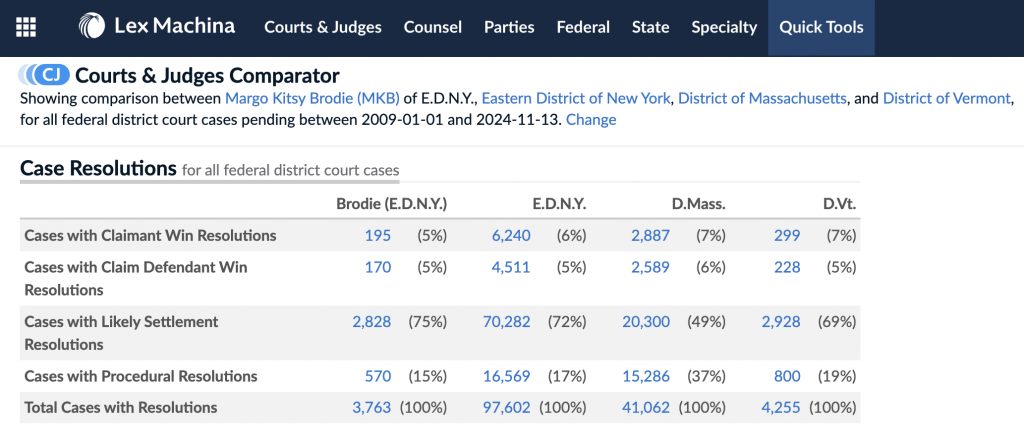The
litigation
analytics
company
Lex
Machina
has
completed
what
it
describes
as
a
milestone
expansion
of
its
data
set
of
court
documents,
adding
another
500,000
federal
district
court
cases
so
that
it
now
has
full
coverage
of
virtually
every
civil
case
filed
in
federal
district
courts
anywhere
in
the
United
States.
The
only
civil
cases
it
does
not
include
are
prisoner
petitions,
which
the
company
deemed
not
commercially
relevant
to
its
customer
base
of
law
firms
and
corporations.
Until
now,
Lex
Machina’s
analytics
have
been
focused
on
specific,
major
practice
areas
(currently
22
practice
areas),
and
in
its
collection
and
tagging
of
federal
cases,
it
prioritized
those
practice
areas.
But
with
this
latest
expansion,
it
has
added
the
remaining
15%
of
district
court
cases
that
did
not
fit
under
one
of
those
major
practice
areas.
“This
is
a
pretty
big
milestone
in
terms
of
our
overall
expansion
to
cover
all
civil
litigation
in
federal
district
court,”
Carla
Rydholm,
general
manager
and
head
of
product
at
Lex
Machina,
told
me
during
a
briefing
this
week.
“Now
we
have
the
ability
to
provide
coverage
of
every
commercially
relevant
case.”
Before
this
update,
some
analytics
showed
a
grey
area
for
the
15%
of
cases
not
accounted
for.
Now,
the
analytics
give
a
full
picture.
While
analytics
by
practice
area
remain
the
primary
focus
of
the
platform,
it
now
allows
users
to
compare
analytics
across
all
federal
cases,
without
having
to
select
a
case
type,
and
then
drill
down
into
more
granular
data
based
on
courts,
judges,
counsel,
parties,
and
other
filters.
In
addition
to
tagging
cases
based
on
the
22
primary
practice
areas,
Lex
Machina
has
now
added
tagging
for
another
five
categories:
admiralty/maritime,
forfeiture/penalty,
FOIA,
immigration,
and
RICO.
Cases
that
do
not
fit
within
any
of
these
practice
areas
will
be
tagged
as
uncategorized,
but
users
will
be
able
to
view
the
federal
nature-of-suit
code
that
was
applied
to
the
original
filing.

Where
comparisons
previously
could
be
done
only
within
a
practice
area,
they
can
now
be
done
across
all
cases.
This
enhanced
data
set
is
also
available
through
the
litigation
analytics
feature
of
the
legal
research
platform
Lexis+.
Lex
Machina
is
owned
by
LexisNexis.
The
significance
of
this
is
that
users
will
get
a
truly
complete
picture
of
federal
court
analytics
that
encompass
not
just
the
85%
of
cases
previously
covered
but
100%
of
cases.
That
means
that
when
they
are
exploring
analytics
for
factors
such
as
outcomes,
damages,
or
remedies,
they
are
getting
the
comprehensive
view.
Key
to
Lex
Machina’s
analytics
is
how
the
company
processes
the
raw
case
data
after
collection
—
cleaning,
tagging,
coding
and
enhancing
the
data
so
that
it
can
be
analyzed
across
a
number
of
parameters.
It
allows
users
to
explore
analytics
based
on
entities
—
judges,
courts,
law
firms,
attorneys
and
parties
—
and
by
outcomes
—
case
resolutions,
timing,
damages,
findings,
remedies
and
motion
metrics.
Lex
Machina
evolved
out
of
a
research
project
launched
in
2006
at
Stanford
Law
School
to
collect
and
analyze
data
on
patent
cases.
Since
its
acquisition
by
LexisNexis
in
2015,
it
has
steadily
added
more
practice
areas,
expanded
into
state
courts,
added
analytics
for
federal
courts
of
appeal,
and
added
Litigation
Footprint
for
visualizing
litigation.
With
this
latest
traunch
of
cases,
Lex
Machina
can
now
provide
these
outcome-driven
analytics,
including
damages
and
case
resolutions,
for
over
3.7
million
federal
district
civil
cases,
based
on
data
from
17.5
million
documents.
Along
with
this
release,
Lex
Machina
has
updated
certain
tools
and
added new
capabilities
that
it
says
will
allow
for
more
depth,
detail,
and
nuance.
A
new
“Custom
Columns”
feature
streamlines
the
creation,
sharing,
and
export
of
customized
reports,
it
says,
while
a
new
“Findings
Search”
feature
allows
users
to
search
findings
within
a
specific
practice
area
for
findings
that
are
most
relevant
to
their
own
case
and
practice.

